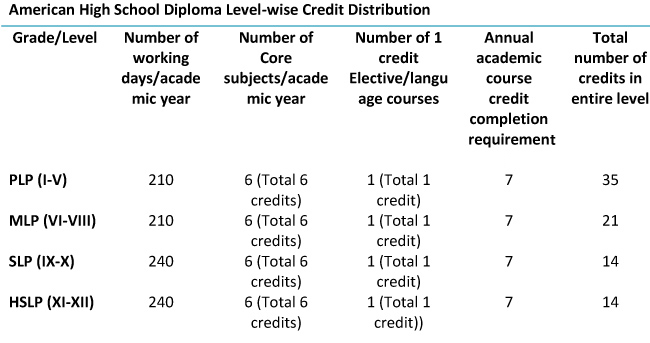
What Is A High School Credit? A Complete Guide
Homeschooling parents for grades 9 through 12 must complete a transcript form that lists the subjects studied, the years of study, the number of credits earned, and the final grades. This means that it is your responsibility to organize the courses your child will take, grade those courses, decide how many credits they are worth, and then record all of this information on their high school transcript.
Since graduation standards are established by each school, homeschooling families can determine their own standards for their own children, which need not be the same for all pupils.
Please read this article to learn more about high school credit if this is a subject that interests you.
About High School Credits
Credits are a way to gauge how well a student has completed their course requirements. The majority of high school courses carry a credit value of either 1.0 (for a one-year course) or 0.5 (for a semester course).
A course’s credit is typically determined by the course’s content, instructional time, and student workload.
You should figure out how many credits your teen needs to graduate from high school, as well as how many credits they need to earn in each subject area when you’re creating their high school plan.
With the help of this information, you will be able to create a course schedule that will help your student and you both stay on track for the entire four years of high school.
You should later put the credits for each course your teen has taken on their transcript so that colleges, universities, trade schools, military recruiters, and employers can quickly and easily see what subjects your student has taken and how thoroughly they studied each one.
Interestingly, public schools in five states employ unusual credit values.
- A semester course receives 5.0 credits in California and 10.0 credits in Nebraska.
- In New Jersey, a one-year course is worth 5.0 credits, while a semester-length course is worth 2.5 credits.
- In Indiana and Idaho, a one-year course is worth 2.0 credits, while a semester-length course is worth 1.0 credits.
Any of those five states permit homeschooling, right? If so, you can either use the 1.0 and 0.5 systems used in most states to calculate credits or follow the example set by the public schools.
However, once you decide on a credit system, you must stick with it for the entire four years of high school.
You decide who gets credit for a parent-taught course. The instructor usually gives credit if your teen enrolls in a course from an outside source. Credit determination is not as clear-cut for co-op courses, though.
Some co-op teachers evaluate student work, assign credit, and determine final grades. Other co-op instructors hand off some or all of these duties to the parent.
For A High School Diploma, How Many Credits Are Needed?
It depends on the state and academic program you are enrolled in (if you are homeschooled, see the article’s bottom for some additional advice). The ranges of credit requirements for the majority of states are listed below.
What Credits Do The Colleges You’re Applying To Require?
The majority of colleges have fairly simple credit requirements, and almost any state’s minimum graduation standards would satisfy the admissions requirements for 90% of institutions.

Some elite colleges are looking for students who can handle a heavier academic load, and some departments or majors may require more credits than the usual minimum (engineering, for example, may prefer students with four or more science credits).
The credits that states typically demand are listed below (again, colleges typically fulfill these requirements to a lesser extent):
- Math: 3 – 4 credits (some states require math every year)
- English: 4 credits
- Science: 3 – 4 credits with labs (some require Biology and/or Physical Science)
- Social Studies: 3 – 4 credits (typically US History, 1/2 credit each in Government and Econ, and 1 – 2 additional credits such as World History or Geography, some require state history)
- Foreign Language: 2 credits (note some programs or selective schools may prefer as many as 4 credits)
- Fine Arts: 1 – 3 credits
- Physical Education: 0.5 – 1 credit (typically 1 year of PE counts for 1/2 credit, so you need 2 years)
- Health: 1/2 credit (not required in all states, some specify “Health and Safety”)
- Personal Finance: 1/2 credit (not required in all states)
- Computers/Technology: 1 credit (not required in all states)
- Electives: 3+ (varies by state, some states require computer courses, others an elective focuses, so check with your state/organization)
In general, students take more courses in ninth and tenth grade and fewer in eleventh and twelfth. This works out well because it gives students more time later in high school to prepare for tests and the application process.
How Do I Get Credits?
Credits can be determined in a few different ways. You can earn credits for using a textbook if you finish 75% of it. This doesn’t mean you have to finish all the questions and answers in the book, but you do want to make sure your child understands everything there is to know.
You may count hours toward credits if you create your own curriculum or learn the material in another way.
According to HSLDA, a credit hour is 120-180 hours. Basic subjects like math and history will be in the 160 range, science courses with labs will be in the 180 range, while electives can be in the 120 range. 60 hours will be required for half-credit courses, and 30 hours should be sufficient for a quarter credit.
For tasks like art, sewing, cooking, web design, or carpentry, to name a few, logging hours works great. They also go on to say that if your student takes a college course for example English 101 and it is a 3 credit course for one semester, you can count it as a full-year one-credit course for their high school year.
Credit calculations for colleges differ from those for high schools. For a one-credit course, a good rule of thumb is 50 minutes per day, five days per week, for a total of 36 weeks.
Goals for high school or college preparation should also be considered. If your student plans to attend college, they will likely take more math and science-related courses; however, if they want to start working right out of high school, they may only need a few credits in these subjects.
Conclusions
Plan ahead and let the student take ownership of their education. Sit down with them to discuss their career goals and assist them in achieving them; you cannot do everything for them. They will gain a lot of knowledge from participating in the planning process. Most colleges require a regular transcript, even though some are happy to accept portfolios for homeschool applicants.


